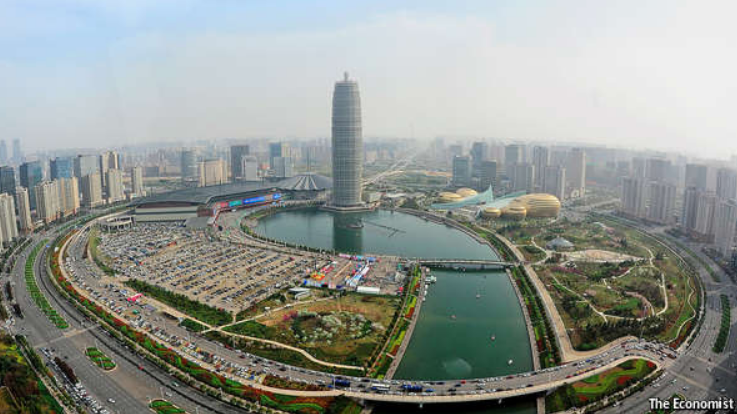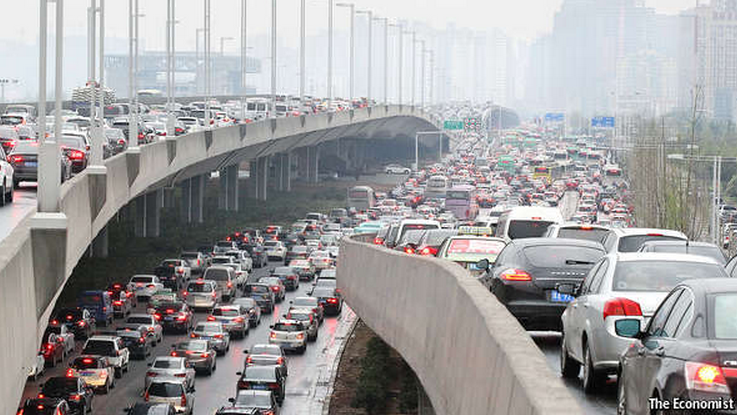A few years back I commented on a “Ghost Cities” story on 60 minutes:
They pointed to a “ghost town” development in Zhengzhou, which is capital of a province of 90 million people. I’d expect its current population (4 million in the urban area) to grow to 10 to 20 million in a few decades. How much longer will that development seem unneeded?
Here’s The Economist:
WHEN “60 Minutes”, an American television news programme, visited a new district in the metropolis of Zhengzhou in 2013, it made it the poster-child for China’s property bubble. “We found what they call a ghost city,” said Lesley Stahl, the host. “Uninhabited for miles and miles and miles and miles.” Two years on, she would not be able to say the same. The empty streets where she stood have a steady stream of cars. Workers saunter out of offices at lunchtime. Laundry hangs in the windows of the subdivisions.
The new district (pictured), on the eastern side of Zhengzhou, a city of 9m in central China, took off when the provincial and city governments relocated many of their offices there. Then, high schools with university-sized campuses began admitting students, drawing families to the area. Last autumn one of the world’s biggest children’s hospitals opened, a gleaming facility with cheery colours and 1,100 beds. Chen Jinbo, one of the area’s earlier residents, bemoans the lost quiet of a few years ago. “Rush hour is a hassle now.”
The success of Zhengzhou’s development belies some of the worst fears about China’s overinvestment. What appear to be ghost cities can, with the right catalysts and a bit of time, acquire flesh and bones. Yet it also marks a turning-point for the Chinese economy. Zhengzhou still has ambitious plans, not least for a massive logistics hub around its airport. With such a big urban area already built up, though, vast construction projects have a progressively smaller impact on the economy. The city’s GDP growth fell to 9.3% last year from an average of more than 13% over the preceding decade. The downward trend will continue. As the capital of Henan, one of the country’s poorest provinces, Zhengzhou had anchored the country’s last, large, fast-growth frontier. Its maturation signals that the slowing of China’s economy is not a cyclical blip but a structural downshift.
Of course there are actual ghost towns in China, such as Ordos, and more are likely in smaller cities. But overall the problem was exaggerated by the media.
Until recently China could grow its way out of debt trouble. That is no longer an option. With deflation arriving and the economy weakening, nominal growth is a third as fast as a few years earlier. In the year to the first quarter of 2015, nominal GDP grew by only 5.8%. The financial system is also far more complex than it was in the late 1990s, the last time China had a surge in bad debts. State-owned banks accounted for almost all lending back then. Since the financial crisis their share has fallen to less than two-thirds. Loosely regulated “shadow banks” make up much of the rest.
That NGDP growth rate is not unreasonable, but China needs to be careful not to allow NGDP growth to slow too rapidly. That could trigger a debt crisis.
A much-needed shift towards consumption-led growth is just getting under way. Investment accounts for 50% of economic output, well beyond what even Japan and South Korea registered in their most intensive growth phases. Without rebalancing, overcapacity in industry would only get more severe, further undermining the return on capital. At last, there are glimmers of hope. Investment growth has halved in recent years but consumption growth has held steady; in future, as China’s growth slows, consumption should contribute a bigger share of it (see chart 3).
. . .
Still more important is a change in economic structure. Services took over from industry a couple of years ago as the biggest part of China’s economy, and the gap has widened. Last year services accounted for 48.2% of output; industry’s share was down to 42.6%. Services are more labour-intensive, which brings two benefits. First, China is now able to generate many more jobs at lower levels of growth. Though growth dipped to its slowest in more than two decades last year, China created 13.2m new urban jobs, an all-time high. Second, the strong jobs market has allowed wages to keep on rising at a steady clip, a prerequisite for getting people to consume more.
Even in Gushi, a county officially classified as impoverished, people throng to clothing stores, beauty parlours and the town’s one foreign restaurant (a KFC). Like many there, Zhang Youling, 43, spent much of his adult life away, going to where the jobs were. He worked as a builder in Beijing, a courier in Shanghai and an ice-cream wholesaler in Zhengzhou before returning to Gushi to be with his wife and two children. For the coming summer, he has set aside 6,000 yuan ($970) to take them to Beijing on holiday. “We used to save everything. These days we have the confidence to spend some of what we earn,” he says.
That last paragraph may not seem surprising to a westerner, but to anyone who spent time in China in the 1990s the idea of a migrant worker family blowing a thousand bucks on a family vacation is utterly mind-boggling. Living standards are rising very fast.
Monetary policy is virtually unrecognisable from five years earlier, when the central bank controlled all key interest rates. Funding costs throughout the economy are now more market-based. Banks compete for deposits with an array of investment products; households place 30% of their savings in bank-account substitutes, up from 5% in 2009. Official deposit rates are still fixed, but regulators have given banks flexibility (currently, a 2.5-3.25% range) and hint at full liberalisation within a year.
The government has also relaxed capital controls. Companies previously needed approval for overseas investments above $100m; late last year the threshold was raised to $1 billion. In recent months, capital outflows have surged. Some say this is because Chinese are losing faith in their country. Regulators are far more sanguine, pointing to it as a sign of a better-balanced economy. The alternative—trapping money in China at artificially low interest rates and encouraging wasteful investment—was bound to be more destructive.
With so many downbeat stories in the media, thank god for the Economist, where you can get some accurate information about China:
China has also disappointed those hoping for bold reforms of sluggish state-owned enterprises, but smaller shifts may help. By injecting assets from unlisted state parents into listed subsidiaries, groups such as Citic will face closer market scrutiny. At the same time, the government is loosening its grip on other important levers. It has simplified the process for registering new companies. Entrepreneurs can now, for instance, use non-cash assets as capital. They created some 3.6m firms last year, up by nearly 50% from 2013.
Reforms are themselves generating new risks. A bull run in the stockmarket over the past six months is beginning to resemble the asset bubbles that often arise when countries plunge into financial liberalisation. But keeping the previous economic system in place would be more dangerous. It would make growth faster in the short term but at the cost of ever more debt, heightening the risk of an eventual crash. Taken together, the policy shifts should smooth China’s transition to slower but more resilient growth.
The transition will take time. For now, investment still accounts for half the economy. In Zhengzhou, a layer of construction dust covers much of the city’s southern half. Along with building a vast new airport terminal, workers are digging tunnels for five new subway lines. Traffic is snarled for hours in the evening as trucks haul pillars into place for elevated highways. The pressing concern for residents stuck in the congestion is not economic collapse but rather the continued headaches of growth, even if it is a little weaker than last year.
Take a look at the traffic jam in this photo, and think about the fact that in the 1990s, or even the early 2000s, essentially nobody in Zhengzhou even owned a car.

